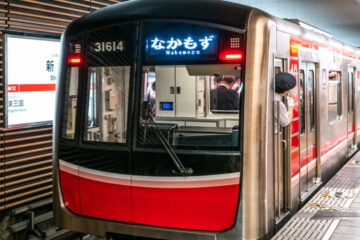SPECIAL
Discover OSAKA
“Along the Osaka Metro Lines”
Series: Imazatosuji Line

2021.05.14
Welcome to Along the Osaka Metro Lines series which showcases the characteristics and notable sights around the nine subway lines of Osaka. The sixth issue of the series presents our newest line, the Imazatosuji Line!
Opened in 2006, the Imazatosuji Line runs 11.9 km between Itakano Station to the north and Imazato Station to the south. Running through the eastern part of Osaka City, the Imazatosuji Line is the Osaka Metro line that does not run inside the JR Osaka Loop Line. Most of the sections are located within Osaka City, the line crosses the city limits at one point and runs partially through Moriguchi City. The golden orange color of this line represents the warmth of the sun rising from the East and was also chosen in the image of the lively residential areas in eastern Osaka.
Osaka Metro’s Second “Linear Metro”
Like the Osaka Metro Nagahori Tsurumi-ryokuchi Line, the Imazatosuji Line uses linear motor-driven trains and the logo “LIM” across its train car stands for Linear Induction Motor. The platforms on this line are shorter than others to match the compact four car trains but are equipped with large elevator equipment capable of accommodating emergency transport needs.


A Whale Bridge?!
The Imazatosuji Line begins at Itakano Station, the northernmost station within the entire Osaka Metro transit system. It’s easy to find the station entrance from afar as many stations on the Imazatosuji Line utilize a vivid orange design for their entrance. Another characteristic of the Imazatosuji Line is that most stations are equipped with underground bicycle parking and stairways conveniently have a built-in ramp for bikes.


The area near Zuiko 4-chome Station has a long history; it is said a great temple was built in the area at the end of Heian Period (794 – 1185 CE). Today, some temples remain in the neighborhood including Zuikoji Temple—the origin of the Metro station name—where you can find Setsugeikyo Bridge, the world’s only “whale bridge” whose railings are whale bones.
As indicated on the station signage—read “大阪経大前” (literally “in front of OUE”)—Osaka University of Economics is located near Zuiko 4-chome Station.

Stunning Sunrise & Sunset
Next stop is Daido-Toyosato. Interestingly, two distinct places called “Daido” exist in this area. When written with Kanji characters—it’s how place names are usually written in Japanese—each “Daido” has its own characters (大道 and 大桐.) For the Station name, however, phonetic Hiragana letters (だいどう) were used instead to represent both “Daido” in the area. Between Daido-Toyosato and Taishibashi-Imaichi stations is a vast Yodogawa Kasen Park where you can enjoy beautiful sunrises and sunsets almost unparalleled in urban settings.

Conveniently connecting the Imazatosuji Line to the Tanimachi Line is Taishibashi-Imaichi Station, whose name combines the local place names of Taishibashi and Imaichi. “Taishi” of Taishibashi refers to Prince Shotoku, reflecting his original plan of building Shitennoji Temple in this area. (The temple was in the end built near Shitennoji-mae Yuhigaoka Station on the Tanimachi Line.)
Charming Edo-era Townscape
The Imazatosuji Line turns toward west after passing Shimizu Station. At the next stop, Shimmori-Furuichi Station, Tsurumi Ryokuchi Expo ’90 Commemorative Park (aka Tsurumi Ryokuchi Park) is located to the east of the station within walking distance. The gigantic park is home to numerous attractions and facilities including Sakuya Konohana Kan, one of Japan’s largest conservatories, various gardens representing different parts of the world, and a horse-riding garden, amongst many others. You can even find artistically designed manhole covers!
It’s An Art!!Manhole Covers that Colorfully Decorate the Streets of Osaka.
https://metronine.osaka/en/article_tour/article-emon01/


Next stop, Sekime-Seiiku, is adjacent to Keihan Line’s Sekime Station, while the following stop, Gamo 4-chome Station offers a quick transfer to Osaka Metro’s Nagahori Tsurumi-ryokuchi Line. Around Gamo 4-chome Station is bustling with restaurants and lots of traffic, but you can also find old houses and rowhouses when stepping into the alleys. Traditional housing in this area was given a new life with the efforts of the Gamo-yon Nigiwai Project which focuses on revitalizing old neighborhoods. Located also close to Kyobashi Station, a destination for many on Nagahori Tsurumi-ryokuchi Line, Gamo 4-chome offers a change of scenery and a nice side trip for the day.

After Shigino Station, located adjacent to JR Shigino Station, is Midoribashi Station. Pump Stations at Osaka City’s third water treatment facility, Nakahama Sewage Treatment Plant, stand tall near Daini Neyagawa River, a class A river running between Shigino and Midoribashi Stations. Seseragi no Sato Park located within the water treatment facility is currently closed temporarily for maintenance work but is popular amongst locals who enjoy a nice stroll.

Connect to Imazato Liner
Imazato Station is the terminus. The waiting room inside the station is perfect when connecting to the Imazato Liner, Osaka Metro’s Bus Rapid Transit system. The bus stands by just outside of the station, keeping you from getting wet on a rainy day♪


Osaka’s Korea Town in Ikuno and Tsuruhashi is an easy access on foot or by bus from Imazato Station. Visit this popular spot and immerse yourself in South Korea within Osaka, shopping and/or savoring yummy street food♪

Osaka’s Korea Town: Korean Street Food & BBQ
https://metronine.osaka/en/article_tour/article-myfirstosaka-food-koreatown-gourmet/
Shopping in Osaka’s Korea Town: A Girl’s Day Out
https://metronine.osaka/en/article_tour/article-myfirstosaka-shopping-koreatown/
Recommended Plans

“Along the Osaka Metro Lines” Series:
The Midosuji Line (South)
Following the last article about the northern part of the Midosuji Line (Namba …
2025.08.29

Where to Stay in Osaka: Umeda, Namba, Shinsekai Area Guide
Are you contemplating a trip to Osaka? Or maybe Osaka is already on your list of places to visit. …
2025.05.02

“Along the Osaka Metro Lines”
Series:《The Chuo Line West》
Here’s the issue two of the series that introduces the characteristics and charms …
2025.04.11






